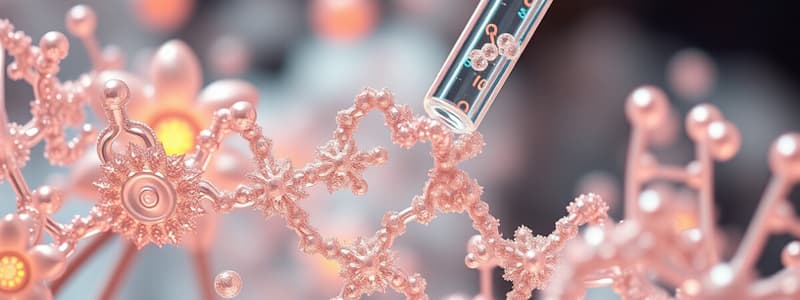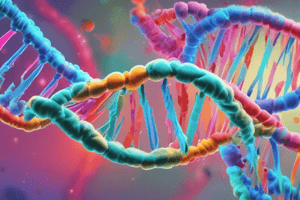Podcast
Questions and Answers
What is the primary function of restriction enzymes in the gene cloning process?
What is the primary function of restriction enzymes in the gene cloning process?
- To cut DNA at specific sequences (correct)
- To replicate the plasmid DNA
- To amplify the gene of interest
- To ligate DNA segments together
Which component is NOT typically required for genetic recombination?
Which component is NOT typically required for genetic recombination?
- Donor DNA
- Competent cells
- RNA polymerase (correct)
- Restriction enzymes
What type of cloning vector is characterized by its ability to replicate independently within a host cell?
What type of cloning vector is characterized by its ability to replicate independently within a host cell?
- Bacteriophages
- Plasmids (correct)
- Animal viruses
- Cosmids
What is the role of DNA ligase in the gene cloning process?
What is the role of DNA ligase in the gene cloning process?
Which step in gene cloning involves introducing the recombinant plasmid into a competent cell?
Which step in gene cloning involves introducing the recombinant plasmid into a competent cell?
Among the following, which is NOT a type of cloning vector?
Among the following, which is NOT a type of cloning vector?
What is a crucial characteristic of an ideal cloning vector?
What is a crucial characteristic of an ideal cloning vector?
Which process occurs after the restriction enzymes cleave both donor DNA and recipient DNA?
Which process occurs after the restriction enzymes cleave both donor DNA and recipient DNA?
What is the function of the Multiple Cloning Site (MCS) in a cloning vector?
What is the function of the Multiple Cloning Site (MCS) in a cloning vector?
Which of the following best describes the role of restriction endonucleases in the cloning process?
Which of the following best describes the role of restriction endonucleases in the cloning process?
What type of ends do EcoRI restriction enzymes produce when cleaving DNA?
What type of ends do EcoRI restriction enzymes produce when cleaving DNA?
Which marker is commonly used in cloning vectors to confirm successful transformation?
Which marker is commonly used in cloning vectors to confirm successful transformation?
What is the role of DNA ligase in the gene cloning process?
What is the role of DNA ligase in the gene cloning process?
Which of the following processes involves the introduction of plasmids into bacterial cells?
Which of the following processes involves the introduction of plasmids into bacterial cells?
What is produced as a result of restriction endonuclease action on plasmid DNA?
What is produced as a result of restriction endonuclease action on plasmid DNA?
What characteristic does the pGEM®-T vector have that aids in the cloning process?
What characteristic does the pGEM®-T vector have that aids in the cloning process?
What is the purpose of T-overhangs at the insertion site in PCR products?
What is the purpose of T-overhangs at the insertion site in PCR products?
Which characteristic is essential for a microbial host organism used in cloning?
Which characteristic is essential for a microbial host organism used in cloning?
How does treatment with CaCl2 affect E. coli cells in the transformation process?
How does treatment with CaCl2 affect E. coli cells in the transformation process?
What is the likelihood that a normal E. coli cell will take up a plasmid DNA molecule without treatment?
What is the likelihood that a normal E. coli cell will take up a plasmid DNA molecule without treatment?
Which method is used to detect the transcript of inserted DNA?
Which method is used to detect the transcript of inserted DNA?
What type of cloning vector characteristics should be avoided to optimize the cloning process?
What type of cloning vector characteristics should be avoided to optimize the cloning process?
What is the primary function of DNA ligase in the cloning process?
What is the primary function of DNA ligase in the cloning process?
In the gene cloning process, which factors are crucial for selecting an appropriate host organism?
In the gene cloning process, which factors are crucial for selecting an appropriate host organism?
Study Notes
Ligation Efficiency
- T-overhangs at insertion sites enhance ligation efficiency of PCR products, especially with thermostable polymerases like Taq polymerase that produce 3' A overhangs.
Host Organisms for Transformation
- Common microorganisms for cloning include bacteria and yeast.
- Suitable strains should lack restriction enzyme activity to prevent degradation of foreign DNA.
- The nucleic acid in the host must be easily separable from the cloning vector.
- Preference for hosts with high metabolic and replication rates.
Transformation Process
- Recombinant DNA enters competent cells and proliferates.
- Normal E. coli cells are inefficient at taking up plasmid DNA; treatment with CaCl2 increases transformation efficiency.
- Approximately one in 10,000 cells may successfully take up plasmid DNA.
Detection and Characterization of Recombinant DNA
- Southern blot hybridization detects inserted DNA.
- Northern blot hybridization is used to detect mRNA of the inserted DNA.
- Western blot hybridization identifies expressed gene products.
- Structural characterization includes the presence of a Multiple Cloning Site (MCS) and selectable markers like antibiotic resistance genes.
Cloning Workflow
- Initial steps involve cutting both target and plasmid DNA with Restriction Endonucleases (RE).
- The ligation of target DNA with plasmid DNA is followed by introducing the ligated DNA into bacterial cells.
- Confirmation of plasmid presence in bacteria is necessary.
Restriction Endonucleases
- REs recognize specific nucleotide sequences and cleave DNA at both strands.
- They are primarily sourced from bacteria, with a few from fungi and algae.
- Bacterial DNA is often methylated to protect it from its own REs.
Ends of DNA Molecules
- RE action leads to either sticky ends or blunt ends (e.g., EcoRI creates sticky ends, SmaI creates blunt ends).
- Both types of ends can be joined using DNA ligase, isolated from E. coli infected with T4 phage.
- Determining the direction of blunt end-ligated DNA requires sequencing.
pGEM®-T Vector
- The pGEM®-T Vector is a linearized vector featuring a single 3'-terminal thymidine at both ends, facilitating easier cloning.
Genetic Recombination
- Gene cloning involves in-vitro modification of genetic material by inserting new genes, resulting in new combinations from isolated DNA segments of different species.
Requirements for Recombination
- Essential components include donor DNA (insert) that contains the required gene, recipient DNA (vector), restriction enzymes, DNA ligase enzyme, and competent host cells for cloning.
Steps of Gene Cloning
- Utilize restriction enzymes to cut the desired gene from donor DNA and cleave the recipient plasmid DNA.
- Ligate the insert to the vector, creating a recombinant plasmid before transformation into competent cells.
Types of Cloning Vectors
- Major cloning vectors include plasmids, bacteriophages, cosmids, yeast artificial chromosomes, and animal viruses.
- Ideal vectors should be small, well-characterized, and capable of autonomous replication within host cells.
Characteristics of Effective Cloning Vectors
- Should be as small as practical for easier manipulation.
- Must have known gene locations and nucleotide sequences.
- Should allow for autonomous replication in host cells, ensuring efficient propagation of the inserted DNA.
Studying That Suits You
Use AI to generate personalized quizzes and flashcards to suit your learning preferences.
Related Documents
Description
This quiz covers the principles of PCR amplification and ligation, focusing on the role of Taq polymerase and the significance of T-overhangs in increasing ligation efficiency. Test your knowledge on the mechanisms behind these processes in a molecular biology context.





